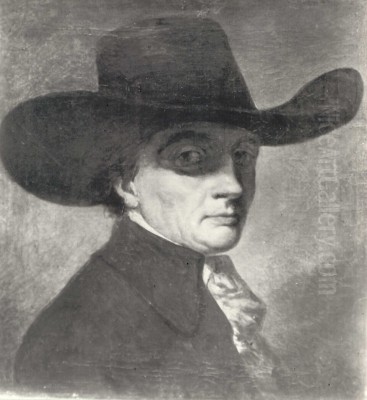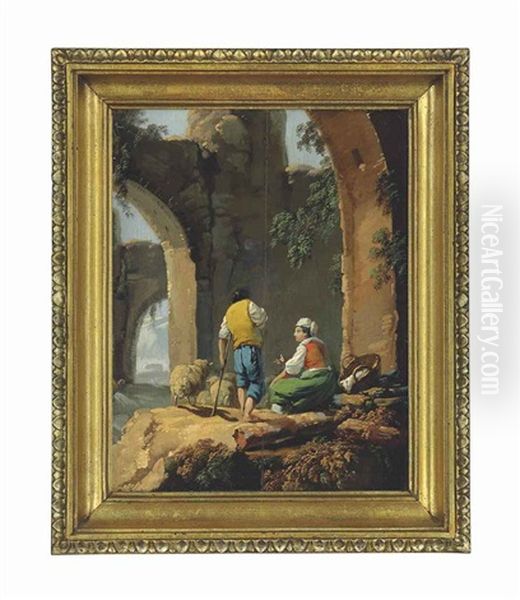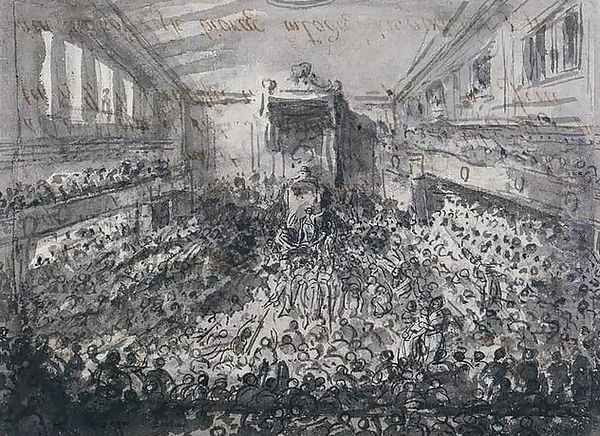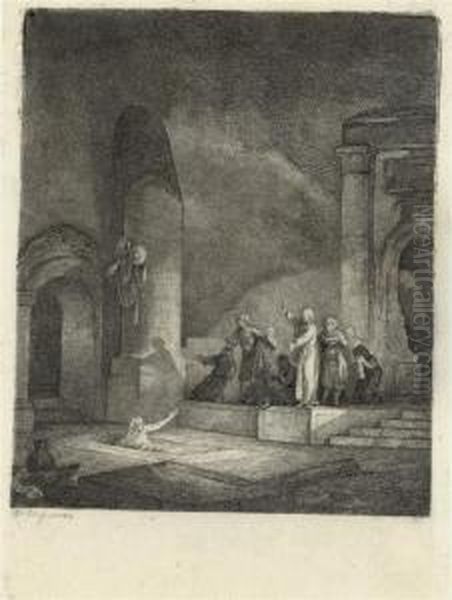
Jean-Pierre Norblin de la Gourdaine stands as a significant, if sometimes underappreciated, figure in late 18th and early 19th-century European art. A French-born artist who spent a crucial thirty-year period of his career in Poland, Norblin became a pivotal conduit for artistic exchange and a keen observer of a nation undergoing profound historical transformations. His multifaceted talents as a painter, draughtsman, etcher, and caricaturist allowed him to capture a wide spectrum of life, from elegant aristocratic gatherings to the raw energy of street scenes and the dramatic intensity of historical events. His legacy is particularly potent in Poland, where he is celebrated not only for his artistic contributions but also for his role as a teacher who helped shape a generation of Polish artists.
Early Life and Artistic Formation in France
Born on July 15, 1745, in Misy-sur-Yonne, France, Jean-Pierre Norblin de la Gourdaine's early artistic inclinations led him to Paris, the undisputed center of the European art world. He immersed himself in the academic environment, studying at the prestigious Académie Royale de Peinture et de Sculpture. His initial training was under Francesco Casanova, a painter known for his battle scenes and landscapes, and the brother of the famous adventurer Giacomo Casanova. Norblin worked in Casanova's studio for a period, likely from around 1763 to 1771, an experience that would have exposed him to the popular genres of the time.
Further honing his skills, particularly in the art of printmaking, Norblin studied engraving with Jacques-Philippe Le Bas, a renowned master in the field. This period was crucial for developing the technical proficiency that would later define much of his oeuvre. The Parisian art scene of the mid-18th century was vibrant and diverse. The Rococo style, with its elegance and lightness, championed by artists like Jean-Antoine Watteau and Jean-Honoré Fragonard, was still influential, though signs of a shift towards Neoclassicism, which would later be epitomized by Jacques-Louis David, were beginning to emerge. Norblin absorbed these currents, but his artistic compass seems to have been particularly drawn to the expressive power and technical mastery of earlier Dutch masters, most notably Rembrandt van Rijn.

Despite his training, Norblin faced professional and social challenges in Paris. He reportedly associated with a circle of artists who were not at the pinnacle of the academic hierarchy and lacked powerful patrons. There's a record of him losing a scholarship from the Royal Academy due to a rule violation, suggesting a somewhat unconventional path or perhaps a rebellious streak. These difficulties may have contributed to his decision to seek opportunities elsewhere, leading him briefly to London and other locales before a pivotal invitation changed the course of his career.
The Polish Sojourn: A New Artistic Horizon
In 1774, at the age of 29, Jean-Pierre Norblin de la Gourdaine accepted an invitation from the influential Czartoryski family to come to Poland. Prince Adam Kazimierz Czartoryski and his wife Izabela Czartoryska were prominent figures in the Polish Enlightenment, patrons of the arts and sciences, and sought to cultivate a vibrant cultural life at their estates, particularly at Puławy. Norblin's arrival marked the beginning of a three-decade sojourn in the Polish-Lithuanian Commonwealth, a period during which he became deeply integrated into the country's artistic and social fabric.
He served as a court painter to the Czartoryskis, a position that provided him with a degree of stability and access to aristocratic circles. His duties would have included painting portraits, decorative works, and scenes of courtly life. Puławy, under Izabela Czartoryska's guidance, was becoming a significant cultural center, and Norblin's presence contributed to its artistic prestige. He was not the only foreign artist working in Poland at the time; for instance, Bernardo Bellotto, nephew of Canaletto, had spent many years in Warsaw, meticulously documenting the city's architecture.
Norblin's engagement with Poland went beyond mere employment. He became a keen observer of Polish life, its customs, its people, and its turbulent history. He eventually gained Polish citizenship, a testament to his deep connection with his adopted country. During his time in Warsaw, he also established an art school, which played a crucial role in the development of Polish painting. He trained a number of students who would go on to become notable artists in their own right, thereby directly influencing the trajectory of Polish art.
Artistic Style: A Fusion of Influences
Jean-Pierre Norblin de la Gourdaine's artistic style is a fascinating amalgamation of his French training, his deep admiration for Dutch Golden Age masters, and his personal observations of Polish life. While the elegance of the French Rococo, particularly the spirit of Antoine Watteau's fêtes galantes, can be discerned in some of his depictions of aristocratic leisure, his most profound artistic debt was to Rembrandt.

Rembrandt's influence is pervasive in Norblin's work, especially in his etchings and drawings. He emulated the Dutch master's dramatic use of chiaroscuro, his ability to convey psychological depth in portraiture, and his interest in capturing the character of ordinary people. Norblin's numerous studies of Polish types – peasants, soldiers, merchants, and Jewish figures – echo Rembrandt's own studies of Amsterdam's diverse population. He was particularly drawn to Rembrandt's etching techniques, including drypoint, which he employed with considerable skill to achieve rich tonal variations and expressive lines.
While artists like Jean-Baptiste Greuze in France were popularizing sentimental genre scenes, Norblin's genre works often had a more robust, observational quality. His approach differed significantly from the burgeoning Neoclassicism of Jacques-Louis David, which emphasized clarity, order, and heroic Greco-Roman themes. Norblin's focus remained more on the particularities of contemporary life and character, rendered with a dynamism that sometimes bordered on caricature. His style was versatile, adapting to the subject matter, whether it was a delicate watercolor, a detailed oil painting, or a vigorously executed etching.
Master of Observation: Key Themes and Works
Norblin's oeuvre is rich and varied, reflecting his keen eye for detail and his engagement with the world around him. His works provide an invaluable visual record of Poland in the late 18th century.
Polish Life, Customs, and Fêtes Galantes:
Norblin excelled at capturing scenes of everyday Polish life and aristocratic leisure. His painting Fête Galante (sometimes referred to with Polish titles reflecting its setting, like Majówka or Towarzystwo w parku na tle świątyni Sybilli w Puławach) is a prime example. It depicts an elegant outdoor gathering, reminiscent of Watteau's idyllic scenes, but set within a recognizable Polish landscape, likely the Czartoryski estate at Puławy. These works often feature lively groups of figures engaged in conversation, music, or games, rendered with a light touch and an eye for costume and social interaction. He also produced numerous drawings and prints of market scenes, street vendors, and rural festivities, showcasing the diverse social fabric of Poland.
Historical Chronicles and Political Commentary:

Living in Poland during a period of immense political upheaval, including the Partitions of Poland and the Kościuszko Uprising, Norblin became an important chronicler of these events. His drawings and paintings of battles, military encampments, and significant political moments are imbued with a sense of immediacy and drama. One of his most famous historical works is related to The Constitution of May 3rd, 1791. While the final, large-scale oil painting of this event is often attributed to others he inspired, Norblin created numerous sketches and studies, and his visual conceptualization of this pivotal moment in Polish history was highly influential. His depictions of the Kościuszko Uprising (1794) are particularly powerful, capturing the fervor and tragedy of the national struggle for independence. Works like Hanging of Traitors in Warsaw's Old Town Square or scenes from the Battle of Racławice demonstrate his ability to convey the intensity of historical events.
His series of satirical drawings known as Sejmiki (depicting local parliamentary assemblies) used caricature and exaggerated elements to critique the often chaotic and corrupt aspects of the Polish political system of the nobility.
Portraits and Character Studies:
Norblin was a skilled portraitist, though his approach often leaned towards character studies rather than formal, idealized representations. His series of etchings, often referred to as Têtes Polonaises (Polish Heads), showcases his fascination with the diverse physiognomies he encountered. These small-scale works, often reminiscent of Rembrandt's character heads, depict a range of individuals – soldiers, peasants, Jews, nobles – each captured with a focus on their distinctive features and expressions. An example like Head of a Man with Pearl Decoration, in Left Profile demonstrates his ability to convey personality even in a small format. These studies are invaluable for their ethnographic and social insights.
Religious and Mythological Subjects:
While less central to his output, Norblin also engaged with religious and mythological themes. Works like Raising of Lazarus show his capacity to handle traditional subjects, often infusing them with the same dramatic lighting and expressive figuration seen in his other works.
The Etcher's Art: A Prolific Printmaker
Jean-Pierre Norblin de la Gourdaine's reputation as a master printmaker is central to his artistic identity. He was particularly proficient in etching and drypoint, techniques he clearly studied through the lens of Rembrandt's graphic work. His output in this medium was prolific, encompassing hundreds of plates.
His etchings cover the full range of his thematic interests: Polish character types, genre scenes, historical events, landscapes, and animal studies. The Têtes Polonaises are perhaps his most famous series of prints, showcasing his skill in capturing individual character in miniature. Works like The Large Bagpiper or studies of Cossacks and street vendors demonstrate his ability to imbue small prints with a sense of life and specificity. He often experimented with different states of his plates, reworking them to achieve varied effects, a practice also common to Rembrandt.
Norblin's mastery of drypoint allowed him to create rich, velvety blacks and subtle tonal gradations, adding depth and atmosphere to his prints. He sometimes combined etching with drypoint to exploit the unique qualities of each technique. His prints were not merely reproductions of paintings but original artistic statements, valued for their technical skill and expressive power. The accessibility of prints also meant that his imagery could circulate more widely, contributing to his influence. His dedication to printmaking underscores his connection to a tradition of artist-printmakers who valued the graphic arts as a primary mode of expression, a lineage that prominently includes Albrecht Dürer, Rembrandt, and later Francisco Goya.
A Teacher and His Enduring Legacy in Poland
Beyond his personal artistic production, Jean-Pierre Norblin de la Gourdaine made a lasting contribution to Polish art through his activities as a teacher. During his time in Warsaw, he established and ran an art school, which became a training ground for a new generation of Polish artists. This was particularly significant as formal art education in Poland was still developing.
Among his most notable students were Aleksander Orłowski and Michał Płoński. Orłowski, like his master, became a versatile artist, known for his paintings and drawings of battle scenes, Polish and Caucasian types, and caricatures. He carried Norblin's observational spirit and interest in national themes into the 19th century, eventually working in St. Petersburg. Płoński also developed into a skilled draughtsman and etcher, clearly influenced by Norblin's style and subject matter. The impact of Norblin's teaching helped to foster a national school of art in Poland, encouraging artists to engage with local subjects and historical narratives.
Norblin's influence extended beyond his direct pupils. His depictions of Polish history, particularly the Kościuszko Uprising, provided iconic imagery that resonated with Polish national sentiment and was drawn upon by later artists. He is considered one of the fathers of Polish genre painting and historical painting. His work provided a visual vocabulary for representing Polish identity and experience during a critical period of the nation's history. While he returned to France in 1804, spending the rest of his life there until his death in Paris on February 23, 1830, his artistic heart, in many ways, remained in Poland.
Navigating Challenges and Controversies
Throughout his career, Norblin faced various challenges. His early years in Paris were marked by a lack of significant patronage and a documented disciplinary issue with the Royal Academy. Even in Poland, while he found consistent employment with the Czartoryskis, his income was reportedly modest for a foreign artist of his caliber – estimated at around 2,500 to 3,000 Polish zlotys annually. His living conditions in Warsaw were described as simple.
Artistically, while his emulation of Rembrandt was a source of strength, it also occasionally drew criticism, with some contemporaries perhaps viewing it as derivative rather than an inspired homage. However, Norblin was not a mere copyist; he absorbed Rembrandt's techniques and spirit and applied them to new subjects and contexts, creating a body of work that was distinctly his own.
His collaboration with Francesco Casanova in his youth also places him in association with a figure who had a mixed reputation among critics and the Academy. However, such workshop collaborations were common, and it is difficult to ascertain the precise nature of Norblin's role beyond that of an assistant or collaborator learning his trade. The political nature of some of his Polish works, particularly the satirical Sejmiki or his vivid depictions of the Uprising, could also have been contentious in certain circles, though they are now valued for their historical and artistic merit.
Norblin's Works in Collections and the Art Market
Today, the most significant holdings of Jean-Pierre Norblin de la Gourdaine's works, particularly his etchings and drawings, are found in Polish institutions. The National Museum in Warsaw houses a vast collection, forming the core of his graphic oeuvre. The Czartoryski Museum in Kraków also holds important works, given his long association with the family.
Beyond Poland, his works are represented in major international collections. The Rijksmuseum in Amsterdam, fittingly, holds pieces like his study related to The Constitution of May 3rd, 1791. The British Museum in London and the Minneapolis Institute of Art are among other institutions that possess examples of his prints, such as Head of Man with Fur Hat and Plume and Young Boy, Facing Right.
Norblin's works appear on the art market, with prints being more common than paintings. Auction records indicate a steady interest in his work. For instance, a significant group of 88 etchings was offered at a Polish auction (AUKCJA DZIEŁ SZTUKI, DESA Unicum) with an estimate of 100,000-110,000 PLN, with a key piece, Ecce Homo, having a starting price of 90,000 PLN. In 2007, a work by Norblin reportedly sold at Sotheby's in London for £75,000. Smaller groups of etchings, such as a lot of 65 pieces at Arenberg Auctions in 2021, fetched prices in the range of €1,500-€2,000. These records demonstrate a continuing appreciation for his skill, particularly as a printmaker.
Enduring Significance: A Cultural Bridge
Jean-Pierre Norblin de la Gourdaine's career is a testament to the rich cross-cultural exchanges that characterized European art in the 18th century. A Frenchman by birth and training, he became a Polish patriot in spirit and a crucial figure in the development of Polish national art. His deep admiration for Dutch masters like Rembrandt, combined with the elegance of his French Rococo heritage and his direct engagement with Polish life and history, resulted in a unique and compelling artistic vision.
He was more than just a court painter; he was a chronicler, a satirist, a teacher, and a technical master of the etching needle. His legacy is twofold: a rich visual archive of a pivotal period in Polish history, and a formative influence on subsequent generations of Polish artists. While perhaps not as globally renowned as some of his contemporaries like Fragonard or David, Norblin's contribution to the artistic landscape of his adopted country, and his broader role as an artist who keenly observed and recorded the human condition, secure his place as an important figure in European art history. His work continues to offer insights into the complexities of culture, identity, and artistic influence across borders.